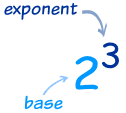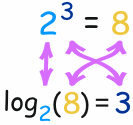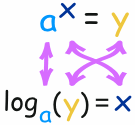Introduction to Logarithms
In its simplest form, a logarithm answers the question:
How many of one number do we multiply to get another number?
How to Write it
We write "the number of 2s we need to multiply to get 8 is 3" as:
log2(8) = 3
So these two things are the same:
 |
The number we are multiplying is called the "base", so we can say:
- "the logarithm of 8 with base 2 is 3"
- or "log base 2 of 8 is 3"
- or "the base-2 log of 8 is 3"
Notice we are dealing with three numbers:
- the base: the number we are multiplying (a "2" in the example above)
- how many times to use it in a multiplication (3 times, which is the logarithm)
- The number we want to get (an "8")
More Examples
Exponents
Exponents and Logarithms are related, let's find out how ...
 |
The exponent says how many times to use the number in a multiplication.
In this example: 23 = 2 × 2 × 2 = 8
(2 is used 3 times in a multiplication to get 8)
|
So a logarithm answers a question like this:

In this way:

The logarithm tells us what the exponent is!
In that example the "base" is 2 and the "exponent" is 3:

So the logarithm answers the question:
What exponent do we need
(for one number to become another number) ?
(for one number to become another number) ?
The general case is:

Common Logarithms: Base 10
Sometimes a logarithm is written without a base, like this:
log(100)
This usually means that the base is really 10.

It is called a "common logarithm". Engineers love to use it.
On a calculator it is the "log" button.
It is how many times we need to use 10 in a multiplication, to get our desired number.
Natural Logarithms: Base "e"
Another base that is often used is e (Euler's Number) which is about 2.71828.

This is called a "natural logarithm". Mathematicians use this one a lot.
On a calculator it is the "ln" button.
It is how many times we need to use "e" in a multiplication, to get our desired number.
But Sometimes There Is Confusion ... !
Mathematicians use "log" (instead of "ln") to mean the natural logarithm. This can lead to confusion:
| Example | Engineer Thinks | Mathematician Thinks | |
|---|---|---|---|
| log(50) | log10(50) | loge(50) | confusion |
| ln(50) | loge(50) | loge(50) | no confusion |
| log10(50) | log10(50) | log10(50) | no confusion |
So, be careful when you read "log" that you know what base they mean!
Logarithms Can Have Decimals
All of our examples have used whole number logarithms (like 2 or 3), but logarithms can have decimal values like 2.5, or 6.081, etc.
Read Logarithms Can Have Decimals to find out more.
Negative Logarithms
| − | Negative? But logarithms deal with multiplying. What could be the opposite of multiplying? Dividing! |
A negative logarithm means how many times to divide by the number.
We could have just one divide:
Or many divides:
It All Makes Sense
Multiplying and Dividing are all part of the same simple pattern.
Let us look at some Base-10 logarithms as an example:
| Number | How Many 10s | Base-10 Logarithm | ||
|---|---|---|---|---|
 | .. etc.. | |||
| 1000 | 1 × 10 × 10 × 10 | log10(1000) | = 3 | |
| 100 | 1 × 10 × 10 | log10(100) | = 2 | |
| 10 | 1 × 10 | log10(10) | = 1 | |
| 1 | 1 | log10(1) | = 0 | |
| 0.1 | 1 ÷ 10 | log10(0.1) | = −1 | |
| 0.01 | 1 ÷ 10 ÷ 10 | log10(0.01) | = −2 | |
| 0.001 | 1 ÷ 10 ÷ 10 ÷ 10 | log10(0.001) | = −3 | |
| .. etc.. | ||||
Looking at that table, see how positive, zero or negative logarithms are really part of the same (fairly simple) pattern.
The Word
"Logarithm" is a word made up by Scottish mathematician John Napier (1550-1617), from the Greek word logos meaning "proportion, ratio or word" andarithmos meaning "number", ... which together makes "ratio-number" !

No comments:
Post a Comment